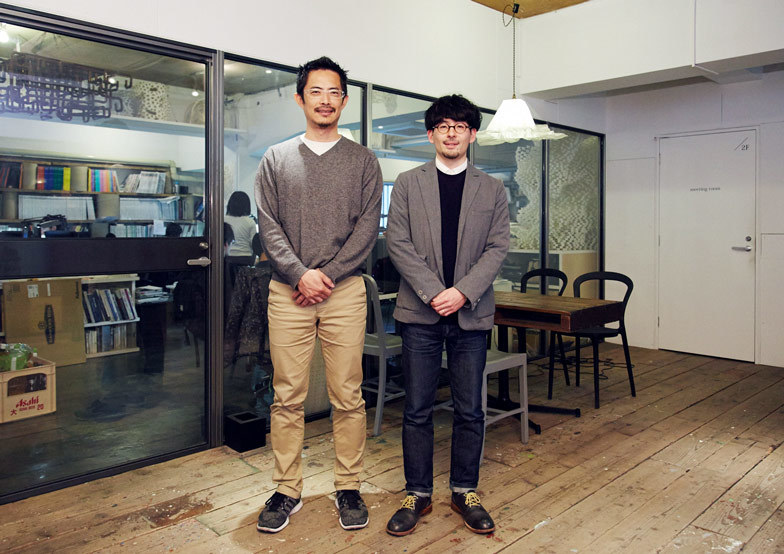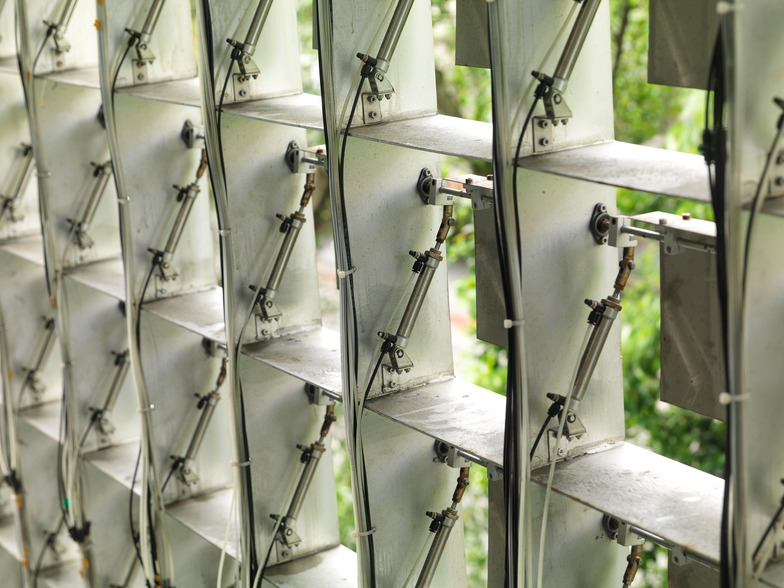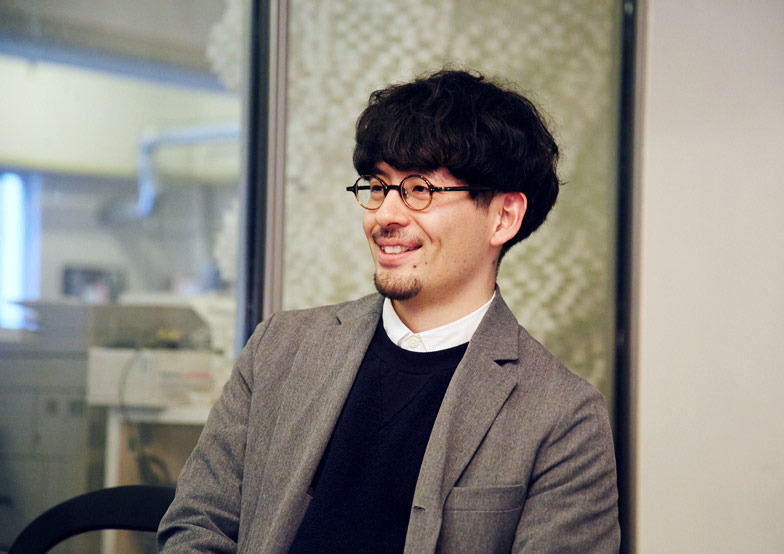"Going to Meet the People I Want to Meet!" Part 5: Dentsu Inc. Event & Space Design Bureau's Yu Nishimuta met with architect Keisuke Toyoda, co-founder of noiz, based in Japan and Taiwan. Looking ahead to the future of an IoT society woven with digital networks, Mr. Toyoda actively develops various experimental works and research activities. He is a top runner in computational architecture. We delve into his problem awareness and his perspective on the future of humanity and society.
Interview & Editing: Aki Kanahara, Dentsu Inc. Event & Space Design Bureau

(From left) Mr. Toyoda, Mr. Nishimuta
What is Computational Design?Nishimuta: Mr. Toyoda's approach of expanding his field from architecture to digital design resonates with our own thinking. We'd like to delve deeper into that today, which is why we requested this time.
Toyoda: Thank you. I often do interviews personally, but I try to communicate as much as possible under the name "noiz." I believe it's important to be a collective. While this Meguro office has some fixed members, I consciously aim to maintain it as a platform-like space where new knowledge, insights, and sensibilities can gather.
noiz is an architecture firm based in Tokyo and Taiwan, with many international projects. Our defining characteristic—though it's always tricky to pin down—is computational design. Simply put, we experimentally and practically explore new possibilities in digital design.
While architecture is our primary focus, we explore how architecture evolves when grounded in information science. Our outputs range from installations and exhibitions to pure programming, and we also engage as consultants. This position fundamentally shifts our own common sense, which is fascinating and drives our daily experimentation.
Digital technology is a medium that changes ecosystems (filling the gaps)
Nishimuta: You once mentioned that "the future of architecture lies outside the field of architecture." You also said that when companies like Pixar enter the architectural domain, the architecture world will change. By expanding the scope of architecture, what kind of future are you envisioning?
Toyoda: The truth is, my own thinking changes every year because technology is evolving so rapidly. Everyone calls digital technology a "tool," but I find that a bit off. In English, I see digital technology as a "medium" – a kind of filling material that bridges the gap.
It's like creatures that had been immersed in air evolved in a certain way, but then suddenly you put them in ethanol. That changes the entire ecosystem, doesn't it? How they take in nutrients, how they move, how their muscles develop, their entire skeleton. How do organisms evolve under those new conditions? In the same way, as the surrounding medium (the digital environment) changes, I believe our way of being immersed in it will also change ecologically.
I want to predict how humans will evolve when the digital environment suddenly crosses the threshold of practical effectiveness. To do that, we need to experience the cutting edge of evolution ourselves through forced cultivation. Architecture is inevitably a heavy, long-term industry, so change happens incredibly slowly. That's our dilemma. When I give research lectures, I end up just agitating people, saying, "Let's change more!" (laughs).
For example, in the music world, digital technology seems to be about 10 to 20 years ahead. Musicians master techniques alone on their computers, constantly creating new things. We observe how this impacts the market and how musicians then transform based on that. We often reference fields where ecosystem changes happen first. I'd also like to collaborate with the music industry.
Designing "sensibilities" and "trends" to reshape common sense
Nishimuta: We also work designing spaces and experiences, but it rarely ends with just hardware design. In fact, I feel our work increasingly involves creating spaces and experiences through the power of software. Our approach seems to place information design at its core.
I used to hold the common sense notion that architecture is "immovable." But seeing noiz's "Flipmata" changed that. It wasn't just about design being "interesting." It felt like it was properly feeding back the movement of the city, the atmosphere of its people, a kind of urban respiration, back into the architecture. It captures the city's information itself and designs with it.


Flipmata (Taipei / 2013, collaboration with Kazuhiro Jo and Why-ixd)
This project began with the idea that, given the structural similarities between visual coding software for sound (Max/MSP) and visual coding software for 3D modeling (Grasshopper), swapping their data might be possible. It explores a new form of communication unique to digital media, where information and sound intersect: converting sounds from the city or school into grid patterns, then transforming the algorithmically generated patterns back into sound and projecting them back onto the city.
Nishimuta: When we consider our work, for example, if asked to design a store, it's not just about the visible design. It could also involve designing new services, designing the applications that run inside, or designing the employee experience to create a new kind of store. By loosely expanding the definition, the possibilities of design also broaden.
Toyoda: Architects are often seen as professionals who design fixed, three-dimensional forms. But as society rapidly changes, even that common understanding becomes misaligned—and that misalignment is fascinating. I'm deeply interested in how digital technology makes these previously intuitive gaps vividly visible or objectively discernible.
I believe the design of experience is also part of architecture. Architects have vaguely addressed the experiences triggered by built objects through design. But in the IoT environment, interconnected network-like systems are becoming broader and more robust. Moving one part affects another—the way technology is activated can create interesting things, new channels, right?
Previously, we operated under a one-to-one, mechanistic value system where one input required one output to take shape. But the moment we accept that we can't control everything, entirely new relationships emerge, enabling operations completely different from before. If we create environments or systems that suggest, "You can kind of foster this kind of tendency," then that tendency actually starts to materialize. It's about designing sensations, designing tendencies, or rather, the technology of indirect design.
It becomes interesting how common sense gets reshaped across various layers, or how digital technology, for instance, doesn't quite mesh well with the ethereal. Ideally, we should be the first to recognize this, demonstrate its form and effectiveness to society, and then share it with everyone. Opportunities to practice such cutting-edge approaches are still scarce; we're in a transitional phase.
Nishimuta: The boundaries between players in different fields are becoming quite blurred.
As we share data across fields and design solutions for other domains using our own strengths, the initiative and advantages once held by specialists in those fields will flatten out, increasing anonymity. What becomes important isn't so much who designed it, but what is being designed.
Toyoda: I'm fascinated by the emergence of increasingly diverse possibilities for the architect's role. While those who relentlessly pursue deep specialization in one area will become even more valuable, I think we'll see a greater shift towards multifocused expertise. We'll increasingly hear stories like: "This architect understands data structures," "This architect can communicate with musicians," "This architect possesses expertise in economics," or "Knowledge from developmental genetics is proving useful in architecture."
I envision a social structure where individuals have two or three focal points of expertise—like understanding the mathematics of economics—and programming and digital technology serve as the connectors. Rather than defining someone's identity by their ability to create amazing forms in architecture, their design power and value would lie in being an architect who also understands genetic engineering and can output forms using economic concepts. I'm deeply fascinated by this kind of professional identity.
※Continued in Part 2











